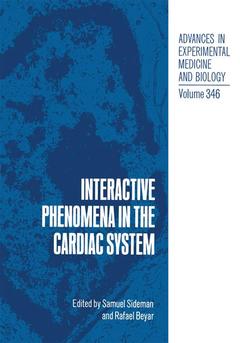Interactive Phenomena in the Cardiac System, Softcover reprint of the original 1st ed. 1993 Advances in Experimental Medicine and Biology Series, Vol. 346
Langue : Anglais
Coordonnateurs : Sideman S., Beyer Rafael

The cardiac system represents one of the most exciting challenges to human ingenuity. Critical to our survival, it consists of a tantalizing array of interacting phenomena, from ionic transport, membrane channels and receptors through cellular metabolism, energy production to fiber mechanics, microcirculation, electrical activation to the global, clinically observed, function, which is measured by pressure, volume, coronary flow, heart rate, shape changes and responds to imposed loads and pharmaceutical challenges. It is a complex interdisciplinary system requiring the joint efforts of the life sciences, the exact sciences, engineering and technology to understand and control the pathologies involved. The Henry Goldberg Workshops were set up to address these multivariable, multidisciplinary challenges. Briefly, our goals are: To encourage international cooperation and foster interdisciplinary interaction between scientists from the different areas of cardiology; to relate microscale cellular phenomena to the global, clinically manifested cardiac function; to relate conceptual modeling and quantitative analysis to experimental and clinical data; to gain an integrated view of the various interacting parameters, identify missing links, catalyze new questions, and lead to better understanding of the cardiac system. The outstanding success of past workshops has encouraged their continuation. The first Henry Goldberg Workshop, held in Haifa in 1984, introduced the concept of interaction between mechanics, electrical activation, perfusion and metabolism, emphasizing imaging in the clinical environment. The second Workshop, in 1985, discussed the same parameters with a slant towards the control aspects.
Cell to Organ: Electromechanical Activation.- 1 Regulation of Intracellular Calcium in Cardiac Muscle.- 2 Neuromodulation of Calcium Current by Extracellular ATP in Isolated Ventricular Myocytes.- 3 Intracellular Calcium and Myocardial Function during Ischemia.- 4 Intracellular Signaling in Vascular Smooth Muscle.- 5 Myocardial Energetics.- 6 Mechanisms of Endocardial Endothelium Modulation of Myocardial Performance.- 7 Calcium Kinetic and Mechanical Regulation of the Cardiac Muscle.- 8 Cellular Responses to Electrical Stimulation: A Study Using a Model of the Ventricular Cardiac Action Potential.- 9 Excitation-Contraction Coupling and Contractile Protein Function in Failing and Nonfailing Human Myocardium.- Mechanics and Microcirculation.- 10 Estimation of Myocardial Mechanical Properties with Dynamic Transverse Stiffness.- 11 Intramyocardial Mechanical States: Vessel-Interstitium-Muscle Interface.- 12 Myocardial Mechanics and Coronary Flow Dynamics.- 13 Modeling of Coronary Capillary Flow.- Microstructure: Mechanics and Microcirculation.- 14 Models for Coronary Pressure-Flow Relationships.- 15In VivoMyocardial Microcirculation: Evaluation with a Whole-Body X-Ray CT Method.- 16 Endocardial Coronary Microcirculation of the Beating Heart.- 17 Distribution and Control of Coronary Microvascular Resistance.- 18 Theoretical Analysis of Coronary Blood Flow and Tissue Oxygen Pressure-Control.- Microcirculation and Metabolic Transport.- 19 Adenosine Coronary Vasodilation during Hypoxia Depends on Adrenergic Receptor Activation.- 20 Chaos in Cardiac Signals.- 21 Intramyocardial Fluid Transport Effects on Coronary Flow and Left Ventricular Mechanics.- 22 Metabolic Protection of Post-Ischemic Phosphorylation Potential and Ventricular Performance.- 23 Metabolic and Mechanical Control of the Microcirculation.- Remodeling of Muscle and Vessels.- 24 Asymmetrical Changes in Ventricular Wall Mass by Asynchronous Electrical Activation of the Heart.- 25 Ventricular Remodeling after Myocardial Infarction.- 26 Arterial Remodelling after Percutaneous Transluminal Balloon Angioplasty.- 27 Structural and Functional Remodeling of Poststenotic Arteries in the Rat.- 28 Myocardial Collagen and Its Functional Role.- Cardiac Function and Circulation.- 29 Ventricular-Arterial Interaction: Cardiac Effects of Mean versus Pulsatile Arterial Load.- 30 The Veins and Ventricular Preload.- 31 Why Smaller Animals Have Higher Heart Rates.- 32 Feedback Effects in Heart-Arterial System Interaction.- Integrated Analysis.- 33 The Relationship between Altered Load and Impaired Diastolic Function in Conscious Dogs with Pacing Induced Heart Failure.- 34 Interactions: The Integrated Functioning of Heart and Lungs.- 35 Carotid-Cardiac Interaction: Heart Rate Variability during the Unblocking of the Carotid Artery.- 36 Right and Left Ventricle Interaction and Remodeling in Congenital Heart Disease.- 37 Macroscopic Three-Dimensional Motion Patterns of the Left Ventricle.- 38 Cardiovascular Flow Velocity Measurements by 2D Doppler Imaging for Assessment of Vascular Function.- The Editors.- Contributors.
Date de parution : 10-2012
Ouvrage de 428 p.
17.8x25.4 cm
Thèmes d’Interactive Phenomena in the Cardiac System :
Mots-clés :
circulation; imaging; mechanics; membrane; metabolism; system
© 2024 LAVOISIER S.A.S.



